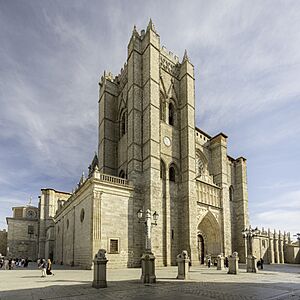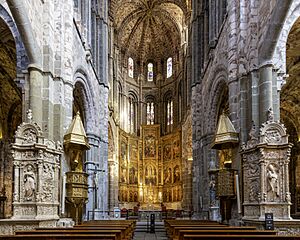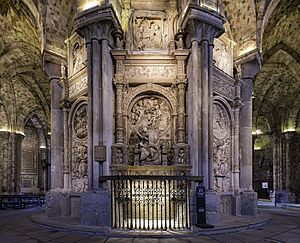Ávila Cathedral facts for kids
Quick facts for kids Ávila Cathedral |
|
|---|---|
| Cathedral of the Saviour | |
| Catedral del Salvador | |

West façade in 2023.
|
|
| 40°39′21″N 4°41′50″W / 40.6558°N 4.6972°W | |
| Location | Ávila |
| Country | Spain |
| Denomination | Catholic |
| History | |
| Status | Cathedral |
| Dedication | Salvator Mundi |
| Architecture | |
| Architect(s) | Giral Fruchel |
| Style | Gothic |
| Groundbreaking | 1170 |
| Specifications | |
| Length | 85 m (278 ft 10 in) |
| Width | 42.5 m (139 ft 5 in) |
| Nave height | 28 m (91 ft 10 in) |
| Administration | |
| Metropolis | Valladolid |
| Diocese | Ávila |
The Cathedral of the Saviour is a large Catholic church located in Ávila, a city in Spain. It is also known as the Catedral de Cristo Salvador in Spanish. This amazing building was designed using both late Romanesque and Gothic styles.
What makes this cathedral special is that it was planned to be a cathedral-fortress. Its back part, called the apse, actually forms one of the towers of the city's old walls. Several important buildings, like the Palace of the Veladas, surround it. These palaces helped protect a gate in the city walls.
Contents
History of Ávila Cathedral
It is not fully known when the construction of the Ávila Cathedral began. There are two main ideas about its start.
Early Beginnings: Two Theories
One idea suggests that a person named Alvar García started building it in 1091. This was on the site of an older church that had been damaged by attacks. Alfonso VII of Castile, a king, then helped gather money to continue the building.
Another idea is that a master builder named Fruchel began the cathedral in the 12th century. This time matches when people were moving back to the region, led by Raymond of Burgundy.
Design and Features
The Cathedral of Ávila is very old, dating back to the 12th century. It is considered one of the first two Gothic cathedrals in Spain. It was built even before other famous Spanish Gothic cathedrals.
Architectural Styles and Influences
The cathedral shows influences from France. It looks a lot like the Abbey Church of St Denis, which was one of the first Gothic churches in Europe. Girald Fruchel started the construction in the 12th century.
Building continued and changed until the 17th century. This means the cathedral has different styles. It started with Gothic, then added Classicism in some parts, and finally Baroque architecture in others.
Construction Over Centuries
The first parts of the towers and the side aisles were built in the 13th century. In the 14th century, more work was done, including the second part of the towers (one was never finished). The cloister, vaults, and flying buttresses were also added then.
By the 15th century, most of the work on the cathedral was complete. In 1475, Juan Guas built a mechanical clock for the cathedral. He also moved the main entrance from the west side to the north side.
The Bell-Ringer's Home
The cathedral's bell tower used to have a home for the bell-ringer and their family. People lived there until the 1950s. A simple system of pulleys and ropes helped them lift food and lower trash.
Inside the Cathedral
The inside of the cathedral is impressive. It has a large central area called a nave and two side aisles. There is also a wide transept, which is the part that crosses the main body of the church.
Main Areas and Decorations
The central nave is much taller than the side aisles. It has big windows that let in a lot of light. Thin columns and pointed arches separate these areas, making the space feel light and open. Most of the ceilings have simple four-part ribbing.
The baptismal font is made of alabaster and was created between 1514 and 1516 by Vasco de la Zarza.
The thick wall behind the main altar, called the ambulatory, is built into the city's strong, fortified wall. A screen, known as a retrochoir, separates the central nave from the transept and the main choir area.
Detailed Artworks
The plateresque retrochoir is beautifully decorated with detailed carvings. These carvings were made by Lucas Giraldo and Juan Rodríguez. They show five scenes from the childhood of Jesus with great detail. In the scene of the Epiphany, Balthasar is shown with dark skin.
Behind the retrochoir are the walnut choir stalls. These seats, which include a misericord, are from the early 16th century. The work was done by a Flemish sculptor named Cornielles de Holanda, with help from Lucas Giraldo, Juan Rodríguez, and Isidro Villoldo.
Altars and Altarpiece
The transept holds two alabaster altars. One is dedicated to Saint Secundus, who is the patron saint of Ávila. The other is for Saint Catherine. Both were made by Vasco de la Zarza in the early 16th century. Isidro Villoldo finished the Saint Secundus altar. Lucas Giraldo and Juan Rodríguez completed the Saint Catherine altar.
The very large altarpiece at the main altar was started by Pedro Berruguete around the late 1400s and early 1500s. He painted eight small panels showing Evangelists and Doctors of the Church. He also painted scenes like "Prayer in the Garden" and "Flagellation." After he passed away, his helper, Bartolomé de Santa Cruz, continued the work. The rest of the scenes were painted by Juan de Borgoña.
Ambulatory and Museum
The ambulatory has a walkway around it and includes nine side chapels. It also has five large, richly decorated panels with carvings. These are thought to be by Lucas Giraldo and Vasco de la Zarza. The middle panel is a detailed alabaster piece by Vasco de la Zarza. It holds the tomb of Alonso de Madrigal, also known as "El Tostado," who was a bishop of Ávila.
The cathedral museum is located in the sacristies, which are rooms used for church items. It has many artworks, including a portrait by El Greco. It also has the chalice and paten of Saint Secundus. The most famous item in the museum is a huge processional monstrance from 1571. This is a special container for the Eucharist, made by the goldsmith Juan de Arphe y Villafañe. It shows the story of "Sacrifice of Isaac."
In 2014, Adolfo Suárez, who was a former prime minister of Spain, and his wife were buried inside the cathedral.
See also
 In Spanish: Catedral de Ávila para niños
In Spanish: Catedral de Ávila para niños




